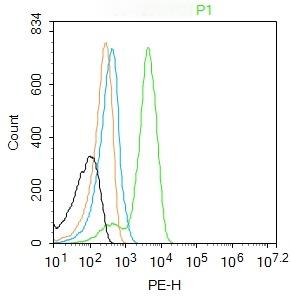Shopping Cart
Remove All Your shopping cart is currently empty
Your shopping cart is currently empty
Anti-BNIP3 Polyclonal Antibody is a Rabbit antibody targeting BNIP3. Anti-BNIP3 Polyclonal Antibody can be used in FCM.
| Pack Size | Price | USA Warehouse | Global Warehouse | Quantity |
|---|---|---|---|---|
| 50 μL | $220 | 7-10 days | 7-10 days | |
| 100 μL | $372 | 7-10 days | 7-10 days | |
| 200 μL | $529 | 7-10 days | 7-10 days |
| Description | Anti-BNIP3 Polyclonal Antibody is a Rabbit antibody targeting BNIP3. Anti-BNIP3 Polyclonal Antibody can be used in FCM. |
| Synonyms | Nip3, Bnip3, BCL2/adenovirus E1B 19 kDa protein-interacting protein 3 |
| Ig Type | IgG |
| Reactivity | Human (predicted:Mouse,Rat,Chicken,Dog,Pig,Cow,Horse) |
| Verified Activity | Blank control: A43 Primary Antibody (green line): Rabbit Anti-BNIP3 antibody (TMAB-00246) Dilution: 2 μg/10^6 cells; Isotype Control Antibody (orange line): Rabbit IgG. Secondary Antibody: Goat anti-rabbit IgG-PE Dilution: 1 μg/test. Protocol The cells were fixed with 4% PFA (10 min at room temperature) and then permeabilized with 0.1% PBST for 20 min at room temperature. The cells were then incubated in 5% BSA to block non-specific protein-protein interactions for 30 min at room temperature. Cells stained with Primary Antibody for 30 min at room temperature. The secondary antibody used for 40 min at room temperature.  |
| Application | |
| Recommended Dose | FCM: 2ug/Test |
| Antibody Type | Polyclonal |
| Host Species | Rabbit |
| Subcellular Localization | Mitochondrion. Mitochondrion membrane. Coexpression with the EIB 19-kDa protein results in a shift in NIP3 localization pattern to the nuclear envelope. Colocalizes with ACAA2 in the mitochondria. |
| Construction | Polyclonal Antibody |
| Purification | Protein A purified |
| Appearance | Liquid |
| Formulation | 0.01M TBS (pH7.4) with 1% BSA, 0.02% Proclin300 and 50% Glycerol. |
| Concentration | 1 mg/mL |
| Research Background | The adenovirus E1B protein is a viral homolog of the Bcl-2 family of proteins that are involved in regulating cell death. A family of interacting proteins, which are designated Nip or Bnip and include BNIP-1, BNIP-2, BNIP-3 and Nix, associate with both the E1B protein and Bcl-2 proteins to mediate apoptotic signaling. BNIP-1 contains a hydrophobic transmembrane domain, which enables its localization to the nuclear envelope, endoplasmic recticulum and mitochondria. BNIP-2, (previously designated Nip2 and Nip21 in human and mouse respectively), shares homology with the non-catalytic domain of Cdc42 GTPase-activating protein (Cdc42GAP). Through binding to Cdc42GAP, BNIP-2 enhances the GTPase activity of Cdc42GAP, facilitating the hydrolysis of GTP bound to Cdc42 and thereby, mediating the signaling pathways involving receptor kinases, small GTPases and apoptotic proteins. Nix, which is also designated Nip3L or Bnip3L, is highly related to BNIP-3, and both proteins localize to the mitochondria where they associate with Bcl-2 proteins. BNIP-3 preferentially binds to Bcl-xL and induces apoptosis by suppressing the anti-apoptosis activity of Bcl-xL. |
| Immunogen | KLH conjugated synthetic peptide: human BNIP3 |
| Antigen Species | Human |
| Gene Name | BNIP3 |
| Gene ID | |
| Protein Name | BCL2/adenovirus E1B 19 kDa protein-interacting protein 3 |
| Uniprot ID | |
| Biology Area | Host Virus Interaction,Cancer,Mitochondrial markers,Hypoxia,Apoptosis,Mitochondrial,Bcl2 Family,Apoptosis,Mitochondrial,Metabolism,Response to hypoxia |
| Function | Apoptosis-inducing protein that, which can overcome BCL2 suppression. May play a role in repartitioning calcium between the two major intracellular calcium stores in association with BCL2. |
| Molecular Weight | Theoretical: 22 kDa. |
| Stability & Storage | Store at -20°C or -80°C for 12 months. Avoid repeated freeze-thaw cycles. |
| Transport | Shipping with blue ice. |
| Size | Quantity | Unit Price | Amount | Operation |
|---|

Copyright © 2015-2026 TargetMol Chemicals Inc. All Rights Reserved.